4. What rural development outcomes have occurred with successful implementation of SARD? |
|
SUMMARY |
|
Eleven cases have been selected to show the positive rural development outcomes that arise from the implementation of SARD. |

The Association for Better Land Husbandry (ABLH) promotes low cost methods of conservation-based farming that reduce poverty, improve rural people's livelihoods and boost rural economies. The approach is called 'near nil investment'. The basic principle is that poor rural families do not have the financial resources to invest in farm improvements. What they need are ways to boost productivity and income by making the best use of available human and natural resources. Double dug beds combined with composting, green and animal manures improve the soil. Good water holding capacity and higher organic matter means that these beds are more productive, more diverse and are able to sustain vegetable growth long into the dry season. Once this investment is made, little more is done for the next 2-3 years. Many vegetables and fruits are cultivated, including kales, onions, tomatoes, cabbage, passion fruit, pigeon peas, spinach, peppers, green beans and soya.
Self-help groups have found that their family food security has improved substantially since adopting conservation farming. Before, they had to use cash when they were short of food in the dry season to pay for maize and vegetables. They had to sell their labour, rely on remittances from family members working elsewhere in the country, or sell cash crops. They would have to do this at a time when food prices were high and labour and cash crop prices low. Many also relied on collecting wild foods from forests. But now, families have found that by working more on their own farms rather than selling labour to others, they are getting greater returns. They have found that investment on their own farms in natural capital pays better returns in food production. Casual hiring out of labour has virtually disappeared among group members. Children have been major beneficiaries, as their health has improved through increased vegetable consumption and longer periods of available food. According to one review of 26 communities in eight Districts, 75 percent of households are now free from hunger during the year, and the proportion of households buying vegetables has fallen from 85 to 11 percent.
® Source: Jim Cheatle, ABLH, Kenya <[email protected]>
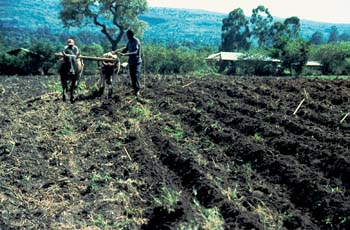
Heifer Project International introduced zero-grazing of dairy production to Uganda. This involves keeping good quality dairy cows in confinement and cut and carry feeding. The system includes production of forages, grasses and leguminous trees. Much of these are grown on bunds and intercropped with food or cash crops thus conserving soil and moisture. The system also results in greater food security and better family nutrition. Animals are a good source of income and food in the dry season and ruminants can use much to the crop and food processing by-products. The gathering of manure and compost from the zero-grazing unit, provides an ongoing source of organic fertilizer and provides for the rapid recycling of limited nutrients within the system. The strengthening of community groups which provide mutual support and training is another significant component.
Dairy heifers are provided as an in-kind loan. Farmers repay the loan by raising a female offspring which is then "passed on" to another farmer in the community. Thus the group has a capital resource which also for the benefit of the program to continue to spread. The zero-grazing system was introduced to Uganda by HPI in 1983, and has survived despite political and economic problems. It has since been adopted by numerous agencies, including the Ministry of Agriculture and International NGOs.
® Source: Carolee Black, HPI
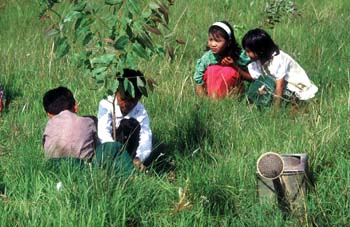
This ITDG project is located in southern Zimbabwe, which falls into Zimbabwe's lowest categories of agricultural potential, and where drought occurs in three out of every five years. An approach which combined low-cost regenerative technologies with building farmers' capacities to participate in research, extension and within group structures has meant that now farmers report that their yields have more than doubled (up 100 percent) since the project was initiated in 1991. The main technologies are water harvesting (tied ridges and infiltration pits) and the adoption of clay pipes and ferro-cement rings for subsurface irrigation of women's vegetable plots. Some 35 women's garden clubs for raising and selling vegetables are now effective and families have become food secure with the greater range of produce spread through the year. According to some community participants "food security is no longer a problem".
The multi-functional benefits of the project include farmers have acquired new skills for food production; local institutions have been strengthened in tackling their own problems; transformative training has increased confidence among local people, particularly poorest groups; increased involvement of women in community decision-making; greater capacity amongst farmers to articulate their needs to service providers, and research and extension systems have become more responsive to farmers needs.
Over 5 000 families have benefited directly from significant increase in income and nutrition, resulting in dramatic improvements in housing and school attendance. Some 10 000 hectares of land have been improved or stabilized by the development of a sustainable small-holder dairy farming system. Over 50 community based groups have been strengthened and these are an engine for rural development. The status of women has been enhanced as over half of the livestock owners are women, many of who are widows with large families.
® Source: Intermediate Technology Development Group
This participatory soil and water conservation project is supported by DFID and is based in upland areas of Gujarat, Rajasthan and Madhya Pradesh. Land degradation is severe, soils are poor, and agricultural production is usually inadequate to support most families. The project works with local groups of 15-25 households on water-harvesting, tree planting, and grazing land improvements. There are now 232 groups in 70 villages: funds raised by each group now average Rs 650, generated mostly from increased agricultural production (giving a total fund base of Rs 151 000).
Basic grain yields (rice, wheat, pigeonpeas and sorghum) have improved from 400 kg/ha to 800-1000 kg/ha. The increased fodder grass production from the terrace bunds is also valued highly. The improved water retention (water tables have risen by one metre over the past 34 years) means that a rabi season crop is now possible for many farmers, turning an unproductive season into a productive one, resulting in a sharp decrease in seasonal out-migration.
® Source: P.S. Sodhi, GVT, Udaipur <[email protected]>
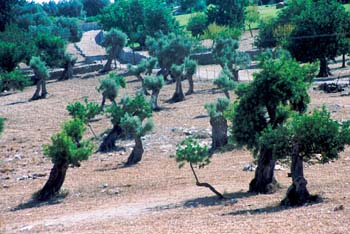
Olive trees have been cultivated for at least two millennia on the Mediterranean coast, contributing to local livelihoods and producing rich and varied habitats for wildlife. But over recent decades, Cilento has suffered from mass emigration, with the young no longer wanting to be olive farmers. Combined with competition from Tunisia, where production costs are lower, pressures on the system are growing.
The CADISPA project coordinated by the University of Strathclyde works closely with local groups in a range of countries to support local regeneration. In Cilento, CADISPA-Italy began working with a local olive oil cooperative, Nuovo Cilento, to introduce organic farming and new marketing methods. Now 130 farmers located in the national park of Cilento are fully organic, using a wide range of resource conserving practices to minimize input use and recycle valuable products, such as using olive husks for fertilizer. They now produce Cilento verde, an extra virgin organic oil of high value. Since the successful regeneration of olive production, cooperative businesses have now been set up for wild chestnut flour production, and ecotourism. These new ventures are largely run by young people, who are increasingly opting to stay in Cilento and use their abilities and skills to develop high quality local goods and services.
® Source: Pretty (1998). The Living Land
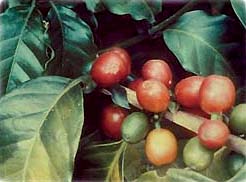
One example of an initiative that began at the local level and has received national recognition is one from Mexico. Indgenas de la Sierra Madre de Motozintla (ISMAM) is a Maya Indian Organic Coffee group in Chiapas. ISMAM was formed by smallholder coffee growers to meet problems of low productivity, poor marketing conditions and extreme poverty of farm families. By adopting organic techniques and improving quality, the coop was able to overcome soil degradation and low yields and move into a privileged speciality market that rewarded their extra efforts towards an ecologically sound production. Through sound, participatory management of the organization and hard work, ISMAM was able to capitalize their enterprise, overcome initial government disinterest and repression to become a major agro-industry with their own processing facilities and direct export markets in the US, Europe and Japan.
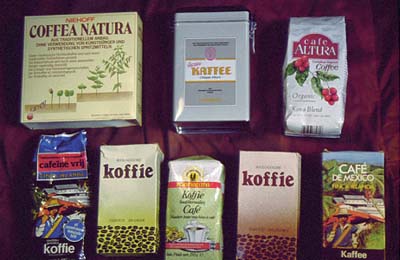
They have begun to produce blends and soluble coffee for the national market and to diversify their agro-production for greater food security. Besides expanding their business, part of ISMAM's profits are returned to regional committees of the coop for investment in social works. In 1995 ISMAM received the National Agro-Export prize from the hands of Mexico's President. They now enjoy a privileged position with respect to credit and government support and have diversified their business into a number of areas including eco-tourism.
® Source: Ronald Nigh
The IFAD-funded soil and water conservation in Illéla district is an example of a key sustainable agriculture technology having substantial multi-functional benefits whilst improving formerly degraded or abandoned lands. Some 5 800 ha of abandoned and degraded lands on the farms of some 6 000 households in 77 villages have been improved with the adoption of tassas (also known as za in Burkina Faso). Large-scale erosion control measures were not successful in the region.
Tassas are 20-30 cm holes dug in soils that have been sealed by a thin surface layer hardened by wind and water action. Since this crust prevents infiltration by water, these areas are usually abandoned, devoid of vegetation, scattered with outcroppings of iron crust, and are prime sites for surface erosion. The holes are filled with manure, since soils in this region are normally lacking in organic matter. This also helps to promote termite activity during the dry season, so further enhancing infiltration. When it rains, the holes fill with water and farmers then plant millet or sorghum. Tassas are normally used in conjunction with stone bunds, taking advantage of the stones that farmers remove from fields for planting. These methods of soil and water conservation were learned by farmers of Illéla on a visit to Yatenga in Burkina Faso where, on the central plateau alone, some 100 000 hectares have been restored each now producing some 700-1 000 kg of cereal per year. According to Hassan (1996), yields of millet without tassas, demi-lunes and contour stone bunds are of the order of 150-300 kg/ha. In the case of tassas they rise to 400 kg with manure in a poor rainfall year, and 700-1 000 kg/ha in a good rain year. Addition of some fertilizer increases yields again - to 650 kg/ha in poor years and 1 400-1 500 kg/ha in good ones.
This soil-development activity has allowed the region to attain average millet yields of 480 kg/ha, reaching levels of up to 700 kg/ha if chemical fertilizer is added (an as-yet uncommon practice). Comparatively, fields of similar quality levels produced only 130 kg/ha According to IFAD, food availability in participating households rose between 20 percent and 40 percent, depending on local rainfall conditions. Reij (1996) indicates that the average family in Burkina Faso and Niger using these sustainable agriculture technologies have shifted from being in annual cereal deficit amounting to 644 kg (equivalent to 6.5 months of food shortage) to producing a surplus of 153 kg per year.
Tassas are best suited to landholdings where family labour is available, or where farm hands can be hired. The technique has spawned a network of young day labourers who have mastered this technique and, rather than migrating, they go from village to village to satisfy farmers' growing demands. There are cases of land being bought back by farmers who recognized early on the profit that can be earned from this land.
Three key factors have contributed to the development and dissemination of this technology in the farming community:
® An action-research approach that combines flexibility, openness to farmer initiatives, a forward-looking attitude and willingness to negotiate;
® A technology that combines the core benefits of innovation: immediate results, simplicity, ability to be integrated into existing cropping systems, and replicability
® A technological package that can adjust to the changing local context.
® Source: Alberta Mascaretti, IFAD; Reij (1996)
In recent years, the protection of either local jobs or the environment have been on collision course in the Pacific North-West. Bitter disputes have erupted over the spotted owl: after it was declared endangered in 1990, the volume of timber harvested in Oregon and Washington fell by a half. But now, new partnerships between formerly hostile groups have emerged, showing just how much sustainable management of natural resources and agriculture can contribute to local economic growth.
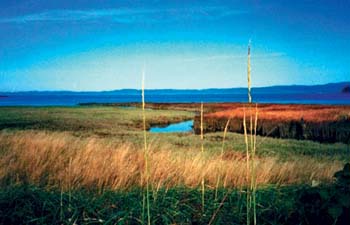
The Willapa watershed comprises 275 000 hectares on the coast of Washington state. It is rich in natural resources, including oysters, clams, crabs, sturgeon, salmon and dense forests. But the four counties that comprise the watershed are extremely poor, and are listed as economically distressed by the state. In addition, natural resources have become diminished: salmon runs have dwindled, sturgeon have almost disappeared, oyster size has fallen, and old growth forests have been replaced by plantations of firs. There is a close connection between the state of resources and local poverty - resources were harvested and shipped out, with few jobs and little income created en route.
The challenge was to create businesses and products that made sustainable use of natural resources and also added value to them. Ecotrust, an environmental group based in Portland, helped to form a new partnership of farmers, oyster growers, fishermen, small businesses, native American groups and others. This 'Willapa Alliance' commissioned studies on resource use and assets, and developed a joint management plan. It was clear that many business ideas existed, but skills and access to markets and credit were in short supply. Ecotrust then contacted a well-established community bank in Chicago, the South Shore Bank, which had invested US$345 million in low-income neighbourhoods for community regeneration since the 1970s. With the support of the Ford Foundation and the SSB, the Willapa Alliance market tested development banking for the watershed. Help has now been given to a range of local businesses that add value to natural resources, including:
® Willapa oysters that are now marketed locally rather than shipped out wholesale;
® cranberry growers who now produce a wide range of products - all cranberries used to be transported out;
® mushrooms which are collected from the forests for sale;
® alder which is harvested from secondary forests for high quality wood products;
® fish and crab which is marketed with the NW image of wholesome foods;
® interweaving of Spartina grasses with denim to make women s summer shoes (Spartina is a weed of shellfish beds and otherwise would be controlled with herbicides).
Many of these have helped local people to make a new livelihood, including the Shoalwater Bay Tribe, who now have formed an oyster company and harvest from 300 hectares of tidal beds. After several years of growing success, a new platform has emerged. The Willapa Economic Development Task Force has now designed an ambitious regional development plan based on sustainable use of natural resources.
® Source: Pretty (1998). The Living Land
World Neighbors has been working in the high mountains of Bolivia (2 800-4 000 masl) in Northern Potos on improving potato productivity since the 1980s. The sandy loam soils suffer from acute erosion, and high population densities have forced cultivation of slopes of up to 50 degrees. High rates of non-literacy, a lack of agricultural research and extension outreach, and deep local suspicion posed severe challenges for the project. In addition, the areas infant mortality rate was 200/1 000; maternal mortality 100/1 000, and average life span a mere 36 years.
At first the project sought to improve livestock and maize production. But after failures, farmers asked them to focus on potatoes. Their interest was in testing new varieties that might help to improve food security using traditional agricultural practices. Crop performance varies dramatically from one hillside to another, and from one ravine to another, and so learning to account for this variability was a central part of the project - which set out to build farmers' own capacity to experiment with new technologies, and to adapt them to their own circumstances. Communities elect their own farmer promoters to help spread lessons learned as well as be the conduit for improved training. Farmers have evaluated many varieties of potatoes in on-farm trials, adopted uniform spacing and deep cultivation, tested green manures (especially lupins) and animal manures, and experimented with variations in seed size. Some 2 000 farmers have improved potato production from about 4 000 k/ha to 10-15 000 kg/ha.
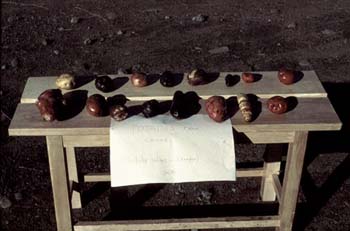
An example of the ways this project has broken away from the norms of agricultural practices centres on the adoption of lupins into crop rotations. The spread of mucuna (velvetbean) in central America, and its extraordinary effect on maize yields, prompted World Neighbors to send 13 farmer promoters from Bolivia and Peru to Honduras. Mucuna does not grow above elevation of 2 800 masl, and would have been destroyed by the process of mounding of soil around potatoes towards harvest. But lupin was identified by Milton Flores as an alternative - it can fix 200 kg N/ha/year, and benefits soils when turned under as a green manure. Farmers were at first incredulous, but their long association with the benefits of experimentation persuaded them to test the practice. Potato yields immediately increased from 1 780 kg/ha to 8 500 kg/ha with lupins, and rose to 13 000 kg/ha when sheep manure was also incorporated. The cash outlay for lupins is US$18/ha, which compares with the US$170/ha for an equivalent amount of inorganic fertilizer.
The project has seen many social benefits, not least improved household food security and health. Once yields improved, many farmers actually reduced their field size, sometimes by as much as 90 percent, so as to focus their intense efforts. Reduced field size turned out to have great benefits for women - making it easier for them to continue to farm whilst men migrate to cities in search of work.
® Source: Ed Ruddell, pers. comm. Ruddell (1995)
Rice-fish culture offers many multifunctional benefits to rural households, economies and environments. At present, only 136,000 ha of the total area of 21 million ha of irrigated rice fields in South East Asia are used for aquaculture. Jiangsu province in China has more than 30 million mu (2 million ha) of rice fields, among which one third are suitable for rice-fish culture. The "The Extension Project of Large-scale, High-yielding, High-effective Techniques of Rice/Aquaculture in Jiangsu Province" project was developed by the provincial government in the mid-1990s, with multi-functional aims: to develop rice/aquaculture combined with reforming and ameliorating low-yielding paddies, ponds and waterlogging farmland for the purpose of increasing food production and income, promoting rural economy, and enriching farmers.

As a result, the rice aquaculture area in Jiangsu Province expanded from about 5 000 ha in 1994 to reach 68 973 ha in 1997. In addition, the area of rice-crab culture expanded to 36 113 ha and rice-shrimp culture reached 13 867 ha. The economic returns of rice aquaculture are remarkable. In 1997 the unit profit of rice/aquaculture fields was 2.86 times that of mono rice cultivation in paddies. Rice-aquaculture systems are low cost, and provide rapid economic returns. They provide an additional source of food and income in rural areas, producing 50 kg of fish per mu.
Rice-aquaculture farming systems also maintain the ecological balance of rice field ecosystems. The rural environment can be improved through the use of non-pollution agriculture - the use of agricultural chemicals is greatly reduced. Rice-fish culture also helps eliminate mosquito larva harmful to human health. Japanese encephalitis and malaria are transmitted by mosquitoes found in a wide belt of Asia, and their prevention depends on improved environmental manipulation to stop mosquito breeding in rice fields. Rice-fish systems provide good control of mosquito incidence. In Quanzhou County, incidence of malaria fell from 11.6/100 000 to 0.1/100 000 as the area of rice-fish cultivation grew from zero to 43 percent over a ten year period.
® Source: Li Kangmin (1998)
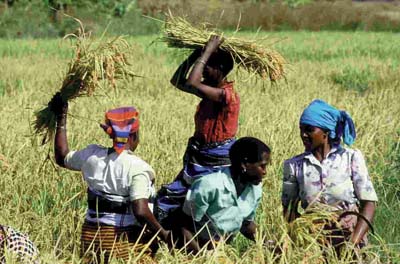
This is an example of an integrated and relatively small-scale project making a substantial impact on regional food security. It has been working in southwest Ethiopia since the drought of 1984, and has introduced of new varieties of crops (vegetables) and trees (fruit and forest), promoted organic manures for soil fertility and botanicals for pest control, and introduced veterinary services. Some 12 500 farm households have adopted sustainable agriculture on about 5 000 ha, resulting in a 70 percent improvement of overall nutrition levels within the project area, along with a 60 percent increase in crop yields. Some farmers have begun to produce excess crops, which they sell in local markets, earning much needed income for their families. Thus an area once reliant entirely on emergency food aid has now become able to feed itself and have enough left over to contribute to surplus. The real promise of the programme, however, lies in the fact that farmers are replicating activities on their own initiative (including those outside the project area), where once they had to be encouraged to participate through food for work payments.
® Source: Food for the Hungry International